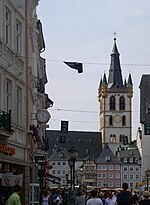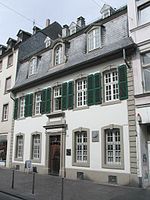Roman Catholic Diocese of Trier

The Diocese of Trier, in English historically also known as Treves ([tɾivz]) from French Trèves, is a Latin Church ecclesiastical territory or diocese of the Catholic church in Germany. When it was the archbishopric and Electorate of Trier, it was one of the most important states of the Holy Roman Empire, both as an ecclesiastical principality and as a diocese of the church. Unlike the other Rhenish dioceses—including Mainz and Cologne–Trier was the former Roman provincial capital of Augusta Treverorum. Given its status, Trier has continuously been an episcopal see since Roman times and is one of the oldest dioceses in all of Germany. The diocese was elevated to an archdiocese in the time of Charlemagne and was the metropolitan for the dioceses of Metz, Toul, and Verdun. After the victory of Napoleon Bonaparte of France, the archdiocese was lowered to a diocese and is now a suffragan in the ecclesiastical province of the Archdiocese of Cologne. The diocesan cathedral is the Cathedral of Saint Peter. The Cathedral Chapter retains the right to elect the bishop, rather than selection by papal appointment.
Excerpt from the Wikipedia article Roman Catholic Diocese of Trier (License: CC BY-SA 3.0, Authors, Images).Roman Catholic Diocese of Trier
Domfreihof, Trier Altstadt (Mitte-Gartenfeld)
Geographical coordinates (GPS) Address Nearby Places Show on map
Geographical coordinates (GPS)
| Latitude | Longitude |
|---|---|
| N 49.756111111111 ° | E 6.6430555555556 ° |
Address
Dom St. Peter zu Trier
Domfreihof 4b
54290 Trier, Altstadt (Mitte-Gartenfeld)
Rhineland-Palatinate, Germany
Open on Google Maps











